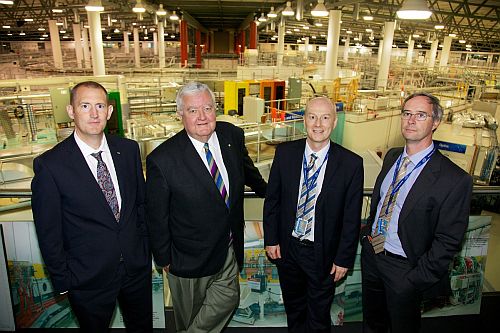18 April 2013
The Australian Synchrotron is enjoying an active program of high-profile industry engagement events over the current month with three major events - the SEMIP Innovation Symposium 2013, industry consultation sessions with the Australian Government’s Manufacturing Industry Innovation Precinct and the inaugural meeting of the Australian Synchrotron’s Industry Advisory Committee (IAC). A central theme to the three major events is the need for greater access to research by industry for innovation, and each event showcased the effectiveness of geographical precincts in connecting these sectors.
SEMIP Innovation Symposium
The Synchrotron is an active member of the South East Melbourne Innovation Precinct (SEMIP), and was responsible for the development of the Innovation Symposium 2013 held on 21 March. SEMIP is a local initiative to help bridge the gap between research and innovation – areas that are well represented in the precinct, 25 kilometres south-east of Melbourne. The precinct is home to 40 per cent of the state’s manufacturing activities – including chemicals, polymers, engineering, and machinery sectors – which are surrounded by the Small Technologies Cluster, Monash University, CSIRO, Monash Biomedical Imaging, and the Synchrotron.
The Chief Scientist of Australia, Professor Ian Chubb was the keynote speaker for the Innovation Symposium. He presented his ‘Top Breakthrough Actions for Innovation’ to high-profile delegation that included representatives from Siemens, Lumen and a number of SMEs, such as Geofabrics Australasia and Megara Australia.

Professor Chubb declared a need for ‘a change in our innovation landscape’ and emphasised, in reference to Australia, that ‘An issue for us is not effort, but scale’.
Photo at left: Chief Scientist of Australia, Professor Ian Chubb addresses the Innovation Symposium 2013
The five breakthrough actions are:
- Establish an Australian Innovation Council
- Strengthen business access to publicly funded research expertise, infrastructure and data
- Encourage mobility of researchers between academia and business or other enterprises
- Harmonise IP frameworks across the publicly funded research sector
- Emphasise the role of STEM (science, technology, engineering and mathematics) education in changing the culture.
A number of other speakers addressed the symposium, notably international guest Mr Kees Eijkel, CEO of Kennispark Twente – a successful innovation precinct in the Netherlands. After the symposium, Kees gave a presentation to staff at the Synchrotron, outlining key strategies and importantly attitudes, that can assist connection with industry. He emphasised that these connections don’t necessarily need to be highly orchestrated with sophisticated events.
‘We identified the postgraduate community of Kennispark, as a group having demonstrated the most drive and energy as innovators,’ Kees said.
‘And how did we harness that energy? Just getting these guys to pull up a milk crate in a cafe and chat with our local business community, as a regular event, has been very effective in establishing high level connections that lead to official engagement.’
Following the Symposium, the Chief Scientist visited the Australian Synchrotron for a tour, including the developing Imaging and Medical Beamline (IMBL), and to meet with senior management. This meeting proved immensely reassuring as Interim Director Professor Andrew Peele checked off the Synchrotron’s outputs and strategy against the ‘breakthrough actions’ advised by the Chief Scientist, to find we are independently implementing an approach that is very much in line with that proposed by the Chief Scientist.


Above left: Mr Kees Eijkel talks to Innovation Symposium 2013 delegates about strategies to bridge the research and economy divide.
Above right: Australia's Chief Scientist (second from left) visits the Synchrotron, to meet with (L-R) Prof. Andrew Peele, Dr David Cookson and Prof. Michael James.
Manufacturing Industry Innovation Precinct
The National Centre for Synchrotron Science was the location for an industry consultation session with state and federal representatives from the Manufacturing Industry Innovation Precinct, an initiative of the Department of Industry, Innovation, Climate Change, Science, Research and Tertiary Education. The new Manufacturing Precinct, as part of this initiative, is to be located in the Synchrotron’s neighbourhood of Clayton. Federal Government representatives were pleased to see over 130 industry senior representatives attend, at an event that was organised at short notice. Attendees were as diverse as large biotech and manufacturers such as Telezon, BAE Systems, and Wilson Transformer Company and even a number of small fashion enterprises.
Chair of the Board for the Precinct, and recently retired Siemens Australia CEO, Albert Goller enthusiastically encouraged encouraged attending businesses to make the precinct theirs.
‘The objectives of the initiative, and those it partners, will be a moving target,’ Albert said.
‘What it will be is highly consultative– the focus will be inclusive of SMEs of all sizes, but we encourage you to make it industry-led. Innovation is for now, not for the next election, not for one year after that. Don’t wait. Let’s talk.’


Above left: Michelle Carr from Telezon Limited makes enquiries about the engagement process of the Manufacturing Industry Innovation Precinct
Above right: Albert Goller Caption: Albert Goller, Chair, Manufacturing Industry Innovation Precinct
Dr Michael Green, General Manager of Manufacturing Innovation from the Department, provided a comprehensive outline of the various stages of the Precinct's development, details of a collaboration fund, and ways for industry to be involved. His slides are available here: Manufacturing Industry Innovation Precinct (pdf 435 KB)
Industry Advisory Committee (IAC)
The inaugural meeting of the Australian Synchrotron’s Industry Advisory Committee will be held this week (19 April). It will be attended by senior representatives from diverse industries such as mining, agriculture, surface coatings and biomedical devices, all with innovation interests in the capabilities of the work done at the Synchrotron. The Committee will meet to review current strategies and also advise senior management on current trends and challenges in their sectors.
For a discussion about how to become involved with the IAC, please contact: kerry.hayes@synchrotron.org.au
